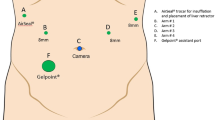Abstract
Despite advantages of minimally invasive surgery, many hepatobiliary surgeons are hesitant to offer this approach for major hepatic resection due to concerns of difficulty in liver manipulation, bleeding control, and suboptimal oncologic outcomes. The robotic surgical system has revolutionized the way traditional laparoscopic liver resection is undertaken. Limitations of traditional laparoscopy are being resolved by robotic technology. We aimed to describe aspects of minimally invasive liver surgery and our standardized technical approach. We discussed technical aspects of performing robotic total right hepatic lobectomy and described our standardized institutional method. A 79-year-old man with an 11-cm biopsy-proven hepatocellular carcinoma was taken to the operating room for a robotic total right hepatic lobectomy. Past medical and surgical history was consistent with hypertension and diabetes mellitus. Robotic extrahepatic Glissonean pedicle approach was used to gain inflow vascular control. Right hepatic artery and portal vein were individually dissected and isolated prior to division. An intraoperative robotic ultrasound was utilized to guide liver parenchymal transection, securing negative margins. Robotic vessel sealing device was used as the main energy device during the parenchymal transection. Right hepatic vein was transected intrahepatically using a linear stapler. Operative time was 200 min without intraoperative complications. Estimated blood loss was 100 ml. Postsurgical recovery was uneventful and he was discharged home on postoperative day 4. Minimally invasive robotic total right hepatic lobectomy is feasible with excellent perioperative outcomes.







Similar content being viewed by others
References
Buell JF, Cherqui D, Geller DA et al (2009) The international position on laparoscopic liver surgery: the Louisville Statement, 2008. Ann Surg 250(5):825–830
Hibi T, Cherqui D, Geller DA et al (2016) Expanding indications and regional diversity in laparoscopic liver resection unveiled by the International Survey on Technical Aspects of Laparoscopic Liver Resection (INSTALL) study. Surg Endosc 30(7):2975–2983
Nguyen KT, Marsh JW, Tsung A et al (2011) Comparative benefits of laparoscopic versus open hepatic resection: a critical appraisal. Arch Surg 146(3):348–356
Croome KP, Yamashita MH (2010) Laparoscopic vs open hepatic resection for benign and malignant tumors: an updated meta-analysis. Arch Surg 145(11):1109–1118
Ryska M, Fronek J, Rudis J et al (2006) Manual and robotic laparoscopic liver resection. Two case-reviews. Rozhl Chir 85(10):511–516
Choi GH, Choi SH, Kim SH et al (2012) Robotic liver resection: technique and results of 30 consecutive procedures. Surg Endosc 26(8):2247–2258
Giulianotti PC, Bianco FM, Daskalaki D, Gonzalez-Ciccarelli LF, Kim J, Benedetti E (2016) Robotic liver surgery: technical aspects and review of the literature. Hepatobiliary Surg Nutr 5(4):311–321
Chandra V, Nehra D, Parent R et al (2010) A comparison of laparoscopic and robotic assisted suturing performance by experts and novices. Surgery 147(6):830–839
Tsung A, Geller DA (2015) Reply to letter: “Does the robot provide an advantage over laparoscopic liver resection?” Ann Surg 262(2):e70–e71
Tsung A, Geller DA, Sukato DC et al (2014) Robotic versus laparoscopic hepatectomy: a matched comparison. Ann Surg 259(3):549–555
Beppu T, Wakabayashi G, Hasegawa K et al (2015) Long-term and perioperative outcomes of laparoscopic versus open liver resection for colorectal liver metastases with propensity score matching: a multi-institutional Japanese study. J Hepatobiliary Pancreat Sci 22(10):711–720
Jarnagin WR, Gonen M, Fong Y et al (2002) Improvement in perioperative outcome after hepatic resection: analysis of 1,803 consecutive cases over the past decade. Ann Surg 236:397–407
Tranchart H, O’Rourke N, Van Dam R et al (2015) Bleeding control during laparoscopic liver resection: a review of literature. J Hepatobiliary Pancreat Sci 22(5):371–378
Qiu J, Chen S, Chengyou D (2016) A systematic review of robotic-assisted liver resection and meta-analysis of robotic versus laparoscopic hepatectomy for hepatic neoplasms. Surg Endosc 30(3):862–875
Ocuin LM, Tsung A (2015) Robotic liver resection for malignancy: current status, oncologic outcomes, comparison to laparoscopy, and future applications. J Surg Oncol 112(3):295–301
Ji WB, Wang HG, Zhao ZM et al (2011) Robotic-assisted laparoscopic anatomic hepatectomy in China: initial experience. Ann Surg 253:342–348
Lai EC, Yang GP, Tang CN (2013) Robot-assisted laparoscopic liver resection for hepatocellular carcinoma: short-term outcome. Am J Surg 205(6):697–702
Author information
Authors and Affiliations
Corresponding author
Ethics declarations
Conflict of interest
Author Sucandy, Author Durrani, Author Ross, and Author Rosemurgy declare that they have no conflict of interest.
Informed consent
All procedures followed were in accordance with the ethical standards of the responsible committee on human experimentation (institutional and national) and with the Helsinki Declaration of 1975, as revised in 2000 (5). Informed consent was obtained from all patients for being included in the study.
Rights and permissions
About this article
Cite this article
Sucandy, I., Durrani, H., Ross, S. et al. Technical approach of robotic total right hepatic lobectomy: How we do it?. J Robotic Surg 13, 193–199 (2019). https://doi.org/10.1007/s11701-018-0881-7
Received:
Accepted:
Published:
Issue Date:
DOI: https://doi.org/10.1007/s11701-018-0881-7




